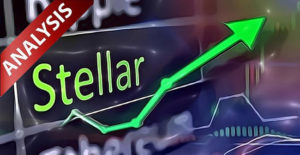- Telecommunications Giant Vodafone Leaves the Libra Association
- Group of Central Banks Assesses Developing Central Bank Digital Currencies
- South Korea Might Impose 20 Percent Tax on Cryptocurrency Profits
- Report: Terrorists Increasingly Use Crypto to Raise Funds Anonymously
- Canadian Securities Administrators Subject Crypto Exchanges to Securities Laws
Stellar (XLM) Price and Analysis
Stellar Overview
Like nearly all other cryptocurrencies, Stellar operates on the principle of a decentralized blockchain – there is no central source of trust or any third parties to go through, it works through a decentralized web of servers interacting. The Stellar blockchain ledger and database support cross-asset transfers of value, including monetary payments. The currency that is native to the platform is called Lumens (XLM).
The basic concept behind Stellar is that you could transfer money to someone across the world, at the lowest exchange rate, within seconds, and the evidence of the transaction will be immutable.
Stellar was released in July 2014 by Jed McCaleb and Joyce Kim. Before the official launch of the platform, McCaleb launched a website named “Secret Bitcoin Project” to test the concept against testers. Shortly after this, the pair set up the Stellar Development Foundation, a nonprofit foundation for developers to the project. At the launch of the project, the network had 100 billion digital coins.
The Stellar platform can handle both cryptocurrency exchanges and fiat-based exchanges (traditional government-backed currency such as the dollar.) In this way Stellar works similar to Ripple. If you’ve read our overview of Ripple you’ll know that Ripple has become popular with some of the world’s major banks for its ability to handle varied payment methods in a quick and convenient way. The aim of both Ripple and Stellar is to offer fast, reliable and affordable global payments, essentially making them rivals of each other.
Ripple has a stronger hold on the banking industry than Stellar does for the time being, but Stellar is growing in popularity year on year. Notably, in 2017, Stellar partnered with IBM on a blockchain banking project.
Both Ripple and Stellar both fall under the umbrella of “non-minable cryptocurrencies”. Usually crypto coins can be mined; however, this isn’t true for all cryptocurrencies. Stellar Lumens (XLM) uses a protocol called Stellar Consensus Protocol, which doesn’t require mining.
The two cryptocurrencies seem pretty similar, so what’s the difference? It largely comes down to your definition of decentralization, or how much importance you place on that aspect of cryptocurrencies. If you spend enough time reading about Ripple and Stellar you’ll come across the following sentiment: “Stellar is essentially a more open source and decentralized version of Ripple”; or for the more aggressive poster, “Ripple is a centralized blockchain run by banks, Stellar is not.”
Ripple uses a network of trusted validators, which does make it less decentralized than Stellar, which uses the config of nodes throughout the network to establish trust.
Latest Stellar News

Crypto Gaming Platform Litemint Completes the Acquisition of Stellarport
Read More

$15M Worth of Stellar (XLM) Moved to the Crypto Exchange Kraken
Read More

Ethereum Keeps Losing Market Share to its Crypto Rivals EOS and Stellar
Read More

Report Reveals Stellar Swept a Bug Worth 2.25 Billion XLM ($10M) Under the Rug
Read More

The Tor Project Enables Cryptocurrency Donations
Read More

Weekly Crypto Market Analysis March 6-13: Stellar Rises, Tron Falters
Read More

Stellar’s Jed McCaleb Says Most Crypto Projects Are BS and Tron Is Just Garbage
Read More

Report: North Korea Deepens Involvement in Cryptocurrency Scams this Year
Read More
Digital favorites
- Siti Di Scommesse
- Casino Bonus Senza Deposito Immediato
- Best Casinos Not On Gamstop
- Casinos Not On Gamstop
- UK Casinos Not On Gamstop
- Non Gamstop Casinos
- UK Casinos Not On Gamstop
- Casino Not On Gamstop
- Non Gamstop Casino
- Slots Not On Gamstop
- Gambling Sites Not On Gamstop
- オンライン カジノ おすすめ
- Gambling Sites Not On Gamstop
- Non Gamstop UK Casinos
- UK Casino Sites Not On Gamstop
- UK Casinos Not On Gamstop
- Non Gamstop Casinos UK
- Non Gamstop Casino Sites UK
- Best Slot Sites
- UK Online Casinos Not On Gamstop
- Best Non Gamstop Casino
- Best Sports Betting Sites Not On Gamstop
